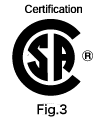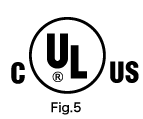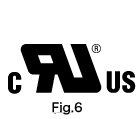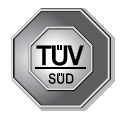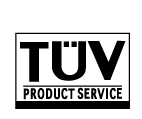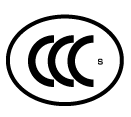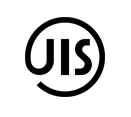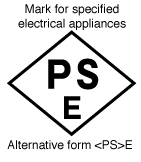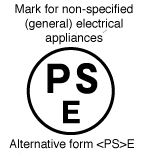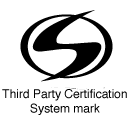[System Maintenance Notice]
Due to ongoing system maintenance, the site search and specification search functions are temporarily unavailable. We apologize for any inconvenience this may cause and appreciate your understanding.
Outline of Major Standards
International Standards
IEC standard / International Electrotechnical Commission
By promoting international cooperation toward all problems and related issues regarding standardization in the electrical and electronic technology fields,
the IEC, a non-governmental organization, was started in October, 1908, for the purpose of realizing mutual understanding on an international level.
To this end, the IEC standard was enacted for the purpose of promoting international standardization.
Return to top
North America
1.United States
UL (Underwriters Laboratories Inc.)
This is a non-profit testing organization formed in 1894 by a coalition of U.S. fire insurance firms, which tests and approves industrial products (finished products).
When electrical products are marketed in the U.S., UL approval is mandated in many states, by state law and city ordinances.
In order to obtain UL approval, the principal parts contained in industrial products must also be ULapproved parts.
UL approval is divided into two general types. One is called "listing" (Fig. 1), and applies to industrial products (finished products).
Under this type of approval, products must be approved unconditionally.
The other type is called "recognition" (Fig. 2), and is a conditional approval which applies to parts and materials.
2.Canada
CSA(Canadian Standards Association)
This was established in 1919 as a non-profit, nongovernmental organization aimed at promoting standards.
It sets standards for industrial products, parts, and materials, and has the authority to judge electrical products to determine whether they conform to those standards.
The CSA is the ultimate authority in the eyes of both the government and the people in terms of credibility and respect.
Almost all states and provinces in Canada require CSA approval by law, in order to sell electrical products.
As a result, electrical products exported from Japan to Canada are not approved under Canadian laws unless they have received CSA approval and display the CSA mark.
Approval is called "certification", and products and parts which have been approved are called "certified equipment", and display the mark shown in Fig. 3.
The mark shown in Fig. 4 is called the "Component Acceptance" mark, and indicates conditional approval which is applicable to parts.
The C-UL mark shown in Fig. 5 (finished products) and Fig. 6 (parts) indicates that the product has been tested and approved in UL laboratories, based on UL and CSA standards,
through mutual approval activities.
Return to top
Europe
EN standard / European Standards/Norme Europeennee(France)/Europaishe Norm (Germany)
Abbreviation for European Standards. A unified standard enacted by CEN/CENELEC (European Standards Committee/European Electrical Standards Committee).
EU and EFTA member nations employ the content of the EN standards into their own national standards and are obligated to abolish those national standards that do not agree with the EN standards.
1.Germany
VDE (Verband Deutscher Elektrotechniker)
The VDE laboratory was established mainly by the German Electric Technology Alliance, which was formed in 1893.
It carries out safety experiments and passes approval for electrical devices and parts.
Although VDE certification is not enforced under German law, punishment is severe should electrical shock or fire occur; therefore, it is, in fact, like an enforcement.
TÜV(Technischer Überwachungs-Verein)
TÜV is a civilian, non-profit, independent organization that has its roots in the German Boiler Surveillance Association, which was started in 1875 for the purpose of preventing boiler accidents.
A major characteristic of TÜV is that it exists as a combination of 14 independent organizations (TÜV Rheinland, TÜV Bayern, etc.) throughout Germany.
TÜV carries out inspection on a wide variety of industrial devices and equipment, and has been entrusted to handle electrical products, as well, by the government.
TÜV inspection and certification is based mainly on the VDE standard.
TÜV certification can be obtained from any of the 14 TÜVs throughout Germany and has the same effectiveness as obtaining VDE certification.
2.England
BSI (British Standards Institution)
BSI was inaugurated in 1931 as in institution for issuing standards of measure, inspection and certifying industrial products.
In England the inspection of electrical goods is arbitrary and certified goods can carry the BSI designated certification label.
BEAB (British Electrotechnical Approvals Board for Household Equipment)
BEAB is a non-profit organization established in 1960.
Intended for electrical household goods that use regular power supplies and for some control components,
BEAB is an acknowledged standard that is based on testing using the BS standard.
3.Denmark
DEMKO (Danmarks elektriske materielkontrol)
DEMKO was established for the safety of certain electrical goods and is based on the 1962 "Heavy Current Regulations" (Part B Appendix 601) that stipulates enforced testing and approval.
4.Norway
NEMKO (Norges Elektriske Materiellkontroll)
By law in 1991, NEMKO was empowered to test and inspect electrical equipment for use in Norway.
Products approved by NEMKO can display the mark shown on the left.
5.Finland
EI (Finnish Electrical Inspectorate) - commonly known as FIMKO (Finnish Electrotechnical Standards)
Since its foundation in 1928, FIMKO has been concerned with electrical safety testing.
As a government-recognized organization, it operates a qualification system based on the stipulations of EI-81 and issues certification.
Some household electrical products and electrical and electronic office equipment require EI certification.
6.Sweden
SEMKO (Svenska Elektriska Materielkontroll-Anstalten)
SEMKO was jointly set up in 1925 by associations from the electrical power supply industry and fire insurance industry.
It was officially approved by the Swedish government in 1935.
SEMKO's mission is to test all electrical equipment used in households, offices, shops, schools,
and other places for conformance with official safety requirements and to issue permits.
7.Switzerland
SEV (Schweizerischen Elektrotechnischen Verein)
This private organization for testing electrical products was established in 1903.
SEV was recognized by the Swiss government in 1954.
Since then, to be sold in Switzerland, designated electrical products and parts must receive SEV accreditation.
8.Austria
OVE (Österreichischen Verbandes für Elektrotechnik)
Founded in 1965, OVE certifies that electrical products and parts conform with legally stipulated safety standards. Approved products display the OVE mark.
9.Netherlands
KEMA (N.V. tot Keuring van Elekrotechnische Materialen)
KEMA was established in 1927 to deal with Dutch electrical safety codes.
The KEMA mark, shown on the left, is normally awarded to cables and cords with conforming PVC insulation materials and to qualified household electrical products.
10.ENEC Mark
An example of ENEC Mark
The ENEC mark, approved by certifying authorities in Europe, is for electronic products.
It can be displayed when a product is compliant with the European safety standard (EN standard).
Device switches that display the ENEC mark can be freely distributed in the European Economic Area.
Return to top
China
GB/Chinese National Standards
Guojia Biaozhun
Domestic standards in China are generally known as GB standards.
The standards are issued and administered by the Standardization Administration of China under the auspices of the China State Bureau of Quality and Technical Supervision.
Chinese codes have been drawn up based on IEC and ISO standards.
Related to China's accession to the WTO, laws such as the Product Quality Law and Import and Export Commodity Inspection Law were passed or revised to bring the relevant rules
and regulations more in line with internationally approved general practices.
Accordingly the former certification systems (CCIB and CCEE) were integrated into the new CCC (China Compulsory Certification) system, which was inaugurated on May 1, 2002.
A First Catalog of Products Subject to CCC Marking (19 groups divided into 132 product categories) has been published with classifications made according to the HS (Harmonized System) code numbers.
In principle, products that comply with the relevant stipulations are recognized under the GB standards and are entitled to display the mark shown on the left.
Return to top
Shipping Codes
1Lloyd's(LR)
Lloyd's Register of Shipping
Headquartered in Britain, Lloyd's Registry administers the marine standards of the Society of Lloyd's.
The safety code stipulates UMS (unmanned machinery space) standards and environmental tests of electrical parts with reference to temperature, vibration, and other operating conditions.
Its stipulations for shipboard control panels have been adopted as international standards.
It does not have, however, a defined system for listing conforming products.
2DNV
DET NORSKE VERITAS
Since the foundation was established in 1864, to evaluate Norwegian merchant vessels, it has become a major international marine classification body.
Now it is involved in ship classification and issues all kinds of certification. About 30 years ago, the organization set up an office in Japan and,
as a recognized international marine classification body, has been processing the certification of shipboard automation devices and other marine equipment.
3NK
Nippon Kaiji Kyokai
Headquarted in Japan, the society registers ships and issues NK class certificates. To ensure compliance with regulations for steel ships,
it conducts safety testing of automation devices and other equipment used on ships. When compliance is verified, type approval can be issued.
If automatic machinery and equipment that has received type approval is installed while a ship is being built, construction surveys may be,
either completely or partially, abbreviated.
Return to top
Japan
1.JIS
Japanese Industrial Standard
JIS regulates Japanese national standards based on the stipulations of the Japanese Industrial Standardization Law.
Excepting food and agricultural sector products, the standards govern the development, production, distribution, and use of industrial products.
The Industrial Standardization Law is mainly concerned with constituting JIS and regulating the use of the JIS mark.
JIS concretely stipulate and regulate quality standards for the JIS marking system.
Products that comply with the relevant JIS stipulations are entitled to display the JIS mark.
In recent years, there has been marked progress in standardizing JIS with the ISO and IEC codes.
2.Electrical Appliance and Material Control Law
The law formerly known as the Electrical Appliance and Material Control Law was revised into the Electrical Appliance and Material Safety Law, which came into force from April 1, 2001.
The law covers electrical appliances normally used in homes and offices and is concerned with hazards (fire, electric shock, etc.) and the prevention of damage that may arise when appliances are used.
It abolished the government certification system and made makers responsible for assuring the compliance of their products.
For specified products, makers should request compliancetesting by a private testing body of the parts or of the entire finished product.
In the two major product divisions designated by the Electrical Appliance and Material Safety Law, there are 112 specified categories and 340 non-specified categories,
and products must be appropriately identified with the new marks shown on the left.
Such parts as items for wiring devices, on which it is difficult to provide marking space, can receive the alternative markings.
3.Third Party Certification System
A product is entitled to display the Third Party Certification System mark after results of evaluation by recognized private testing bodies prove that the product complies with technical standards.
Return to top
Return to top
 Business
> Industrial Devices
> Automation Controls Top
> Service & Support
> Standards Certification
> Outline of Major Standards
Business
> Industrial Devices
> Automation Controls Top
> Service & Support
> Standards Certification
> Outline of Major Standards




